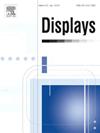Simulated bobbing in walking and running in virtual reality
IF 3.7
2区 工程技术
Q1 COMPUTER SCIENCE, HARDWARE & ARCHITECTURE
引用次数: 0
Abstract
In this study, a psychophysical experiment was carried out to develop and evaluate a bobbing mechanism that can replicate natural human walking and running movement in virtual reality (VR), aiming to enhance realism and user comfort. Subjects were required to adjust oscillation amplitudes to determine the most comfortable level of bobbing during walking and running in VR while in real world the subjects remained still. The experimental results indicate clear preference for vertical oscillation with subjects’ minimal variation across different velocities, emphasising the necessity of simulated bobbing to enhance realism and comfort without inducing discomfort. The average vertical oscillation amplitude was ±0.695 cm for walking and ±1.351 cm for running. Lateral rotation showed more variability, with an average roll amplitude of ±0.186°for walking and ±0.334°for running. These findings suggest that vertical oscillation is critical for providing more immersive and comfortable VR experiences, and that the bobbing simulation might be a useful tool for addressing VR cybersickness.
求助全文
约1分钟内获得全文
求助全文
来源期刊

Displays
工程技术-工程:电子与电气
CiteScore
4.60
自引率
25.60%
发文量
138
审稿时长
92 days
期刊介绍:
Displays is the international journal covering the research and development of display technology, its effective presentation and perception of information, and applications and systems including display-human interface.
Technical papers on practical developments in Displays technology provide an effective channel to promote greater understanding and cross-fertilization across the diverse disciplines of the Displays community. Original research papers solving ergonomics issues at the display-human interface advance effective presentation of information. Tutorial papers covering fundamentals intended for display technologies and human factor engineers new to the field will also occasionally featured.
 求助内容:
求助内容: 应助结果提醒方式:
应助结果提醒方式:


